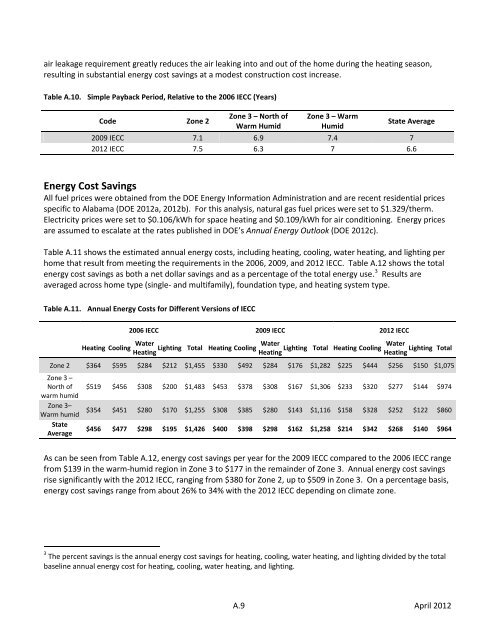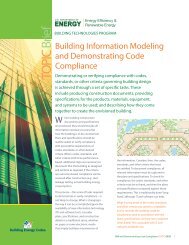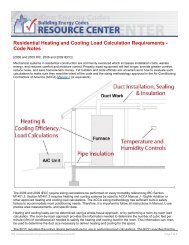Alabama - Building Energy Codes
Alabama - Building Energy Codes
Alabama - Building Energy Codes
You also want an ePaper? Increase the reach of your titles
YUMPU automatically turns print PDFs into web optimized ePapers that Google loves.
air leakage requirement greatly reduces the air leaking into and out of the home during the heating season,<br />
resulting in substantial energy cost savings at a modest construction cost increase.<br />
Table A.10. Simple Payback Period, Relative to the 2006 IECC (Years)<br />
Code Zone 2<br />
Zone 3 – North of<br />
Warm Humid<br />
Zone 3 – Warm<br />
Humid<br />
State Average<br />
2009 IECC 7.1 6.9 7.4 7<br />
2012 IECC 7.5 6.3 7 6.6<br />
<strong>Energy</strong> Cost Savings<br />
All fuel prices were obtained from the DOE <strong>Energy</strong> Information Administration and are recent residential prices<br />
specific to <strong>Alabama</strong> (DOE 2012a, 2012b). For this analysis, natural gas fuel prices were set to $1.329/therm.<br />
Electricity prices were set to $0.106/kWh for space heating and $0.109/kWh for air conditioning. <strong>Energy</strong> prices<br />
are assumed to escalate at the rates published in DOE’s Annual <strong>Energy</strong> Outlook (DOE 2012c).<br />
Table A.11 shows the estimated annual energy costs, including heating, cooling, water heating, and lighting per<br />
home that result from meeting the requirements in the 2006, 2009, and 2012 IECC. Table A.12 shows the total<br />
energy cost savings as both a net dollar savings and as a percentage of the total energy use. 3 Results are<br />
averaged across home type (single- and multifamily), foundation type, and heating system type.<br />
Table A.11. Annual <strong>Energy</strong> Costs for Different Versions of IECC<br />
2006 IECC 2009 IECC 2012 IECC<br />
Heating Cooling Water<br />
Water<br />
Water<br />
Lighting Total Heating Cooling Lighting Total Heating Cooling Lighting Total<br />
Heating Heating Heating<br />
Zone 2 $364 $595 $284 $212 $1,455 $330 $492 $284 $176 $1,282 $225 $444 $256 $150 $1,075<br />
Zone 3 –<br />
North of $519 $456 $308 $200 $1,483 $453 $378 $308 $167 $1,306 $233 $320 $277 $144 $974<br />
warm humid<br />
Zone 3–<br />
Warm humid<br />
$354 $451 $280 $170 $1,255 $308 $385 $280 $143 $1,116 $158 $328 $252 $122 $860<br />
State<br />
Average<br />
$456 $477 $298 $195 $1,426 $400 $398 $298 $162 $1,258 $214 $342 $268 $140 $964<br />
As can be seen from Table A.12, energy cost savings per year for the 2009 IECC compared to the 2006 IECC range<br />
from $139 in the warm-humid region in Zone 3 to $177 in the remainder of Zone 3. Annual energy cost savings<br />
rise significantly with the 2012 IECC, ranging from $380 for Zone 2, up to $509 in Zone 3. On a percentage basis,<br />
energy cost savings range from about 26% to 34% with the 2012 IECC depending on climate zone.<br />
3 The percent savings is the annual energy cost savings for heating, cooling, water heating, and lighting divided by the total<br />
baseline annual energy cost for heating, cooling, water heating, and lighting.<br />
A.9 April 2012
















